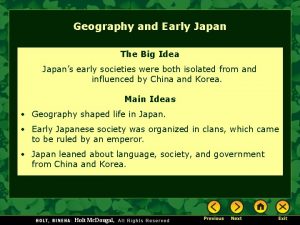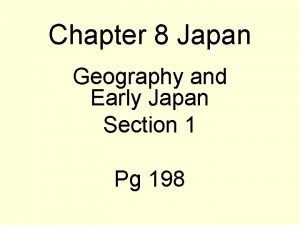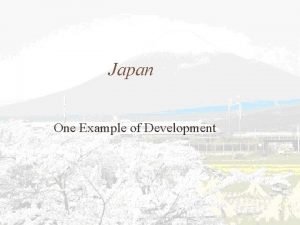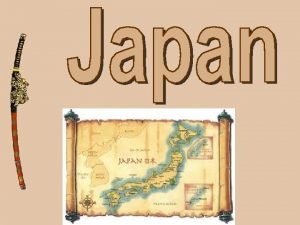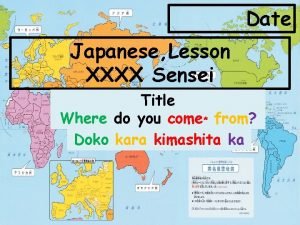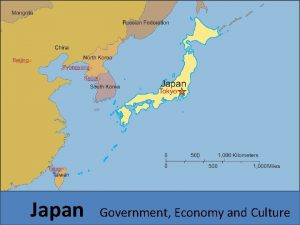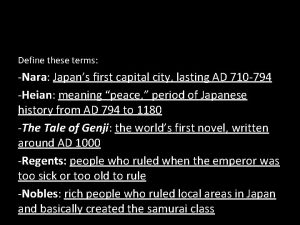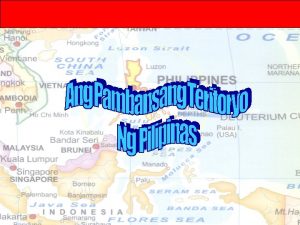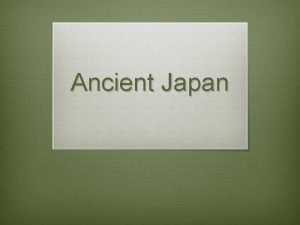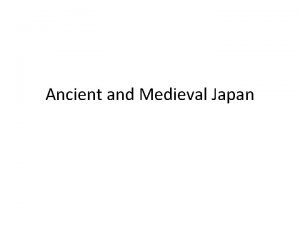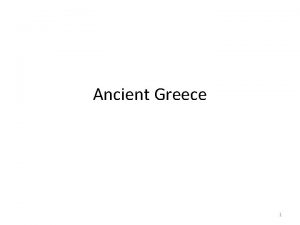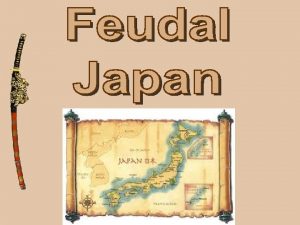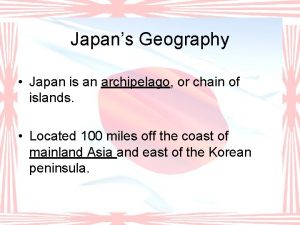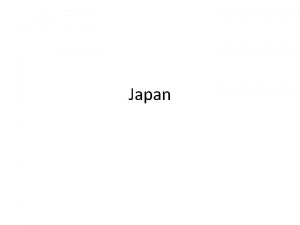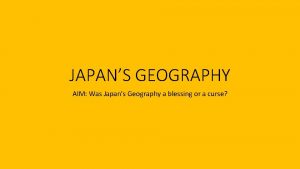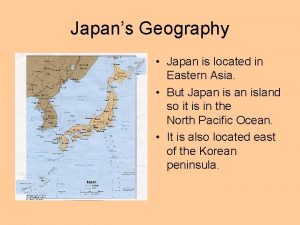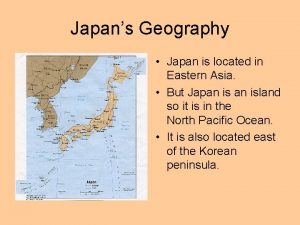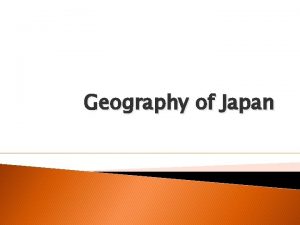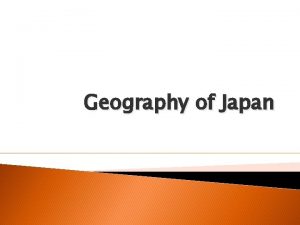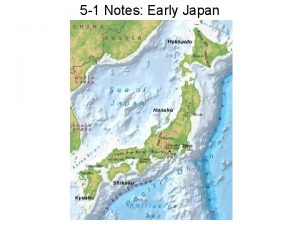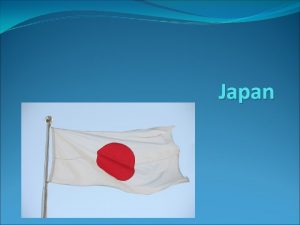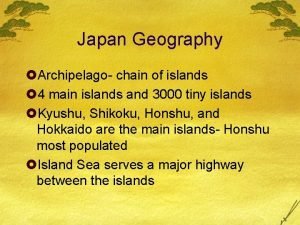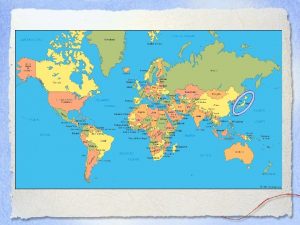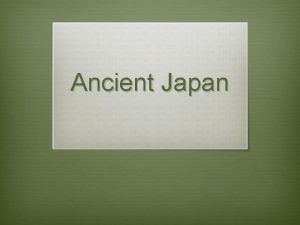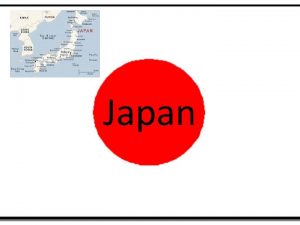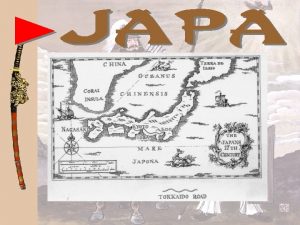Geography of Japan Japans located on an archipelago






















- Slides: 22


Geography of Japan • Japan's located on an archipelago • Or Chain of Islands • • • Main Islands are Hokkaido, Honshu, Kyushu, and Skikoku Size of Montana • 4/5 covered in mountains

The Emperor • Early Society divided into Clans – The Yamamoto clan came to dominate – Symbol: Rising Sun – Emperor still traces lineage to them

Japanese Warfare • Clans fight for power • Samurai (Bushi) were the “knights” of Japan • Small armies • Focused on single combat • Honor and Ritual

Bushido • Samurai (Bushi) = one who serves • Seppuku = is a form of Japanese ritual suicide by disembowelment. • Code of behavior: Bushido – The way of the warrior

Equipment NOTE: Mostly Archers!

Heian Period (794 -1156) • Fujiwara Family in charge • Important cultural period in Japan • Marked by massive clashes of clans • Came to an end with the Genpei War

Kamakura Shogunate (1185– 1333) • Minamoto clan wins • Minamoto Yoritomo named Shogun • battles mostly suppressing rebellions • Invaded by Mongols

MONGOL INVASIONS

First Invasion • Japanese are repeatedly defeated – Not used to fighting large scale • Mongols caught in a typhoon, most ships lost • Surviving ships boarded and Bushi destroy Mongols

Second Invasion • History states 150, 000 Mongols – That would be the scale of D-Day – 10 times the distance, likely 15 -70, 000 • They were repulsed by Japanese forces – Had built defensive walls • Typhoon hits, sinks the fleet – Kamikaze – Divine Wind *First use of hand held gunpowder bombs

Muromachi Period • Costs of Mongol invasion and Massive earthquake caused decline • Emperor Go-Daigo starts Genkō War – Gains imperial power briefly – Ashikaga shogunate was established – Nanboku-chō Wars between Go-Daigo and the Shogun last 50 years • Go-Diago’s Court loses

Muromachi Significance • • • Battles grew larger/less ritualized strategies and tactics emerge greater organization within armies The katana begins to be used Shift to Infrantry from Archery Daimyo Fuedal system is established.

Japanese Feudal Hierarchy

Feudal Hierarchy • Emperor – Figure Head • Shogun – military dictator; Ruled through puppet emperors • Daimyo – Regional Military Governors • Bushi (Samurai) – loyal warriors of local lords • Ronin – Unemployed Bushi


Sengoku Period (1467– 1603)

Sengoku Period (1467– 1603) • Peace destroyed by Ōnin War • a roughly ten-year struggle that converted the capital of Kyoto into a battlefield and a heavily fortified city that suffered severe destruction. • This gave rise to the Senguko (warring states) Period • Daiymos fought each other for power • The authority of both the shogunate and the Imperial Court had weakened,

Sengoku Period (1467– 1603) • This period, named for the increasingly important castle-cities, is marked by the introduction of firearms, after contact with the Portuguese, and a further push towards all-out battle, away from individual combats and concepts of personal honor and bravery. • The arquebus was introduced to Japan in 1543, by Portuguese on board a Chinese ship that crashed upon the tiny island of Tanegashima in the southernmost parts of

Uniting Japan

Uniting Japan • Shogun Toyotomi Hideyoshi – Commoner – United most of Japan with his Army – Failed to conquer Korea and Japan • Shogun Tokugawa Ieyasu – Conquered Japan – Centralized Government – Peace brought prosperity – Tokugawa shogunate would rule until 1868

Edo period (1603– 1867) • This period was one of relative peace under the authority of the Tokugawa shogunate, a forced peace that was maintained through a variety of measures that weakened the daimyōs and ensured their loyalty to the shogunate. The Tokugawa peace was ruptured only rarely and briefly prior to the violence that surrounded the Meiji Restoration of the 1860 s.
 Japans physical geography
Japans physical geography Describe japan’s geography.
Describe japan’s geography. Japans geography
Japans geography Archipelago definition geography
Archipelago definition geography Xxxx japans
Xxxx japans Japans educational system
Japans educational system Japans isolation
Japans isolation Japans type of government
Japans type of government First capital city of japan
First capital city of japan Japan southern hemisphere
Japan southern hemisphere Ringi seido
Ringi seido Gulag archipelago
Gulag archipelago Ang pilipinas ay isang arkipelago
Ang pilipinas ay isang arkipelago Japan physical geography
Japan physical geography Japan physical geography
Japan physical geography Geography of medieval japan
Geography of medieval japan Geography of japan
Geography of japan Proruption ap human geography
Proruption ap human geography Frq ap human geography format
Frq ap human geography format 5 themes of geography ap human geography
5 themes of geography ap human geography What continent is dubai located
What continent is dubai located Vas deferens
Vas deferens Where is greece located
Where is greece located
